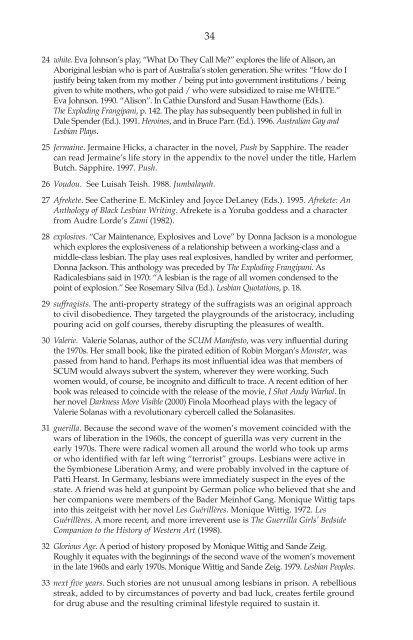Butterfly Effect - ressourcesfeministes
Butterfly Effect - ressourcesfeministes
Butterfly Effect - ressourcesfeministes
Create successful ePaper yourself
Turn your PDF publications into a flip-book with our unique Google optimized e-Paper software.
24 white. Eva Johnson’s play, “What Do They Call Me” explores the life of Alison, an<br />
Aboriginal lesbian who is part of Australia’s stolen generation. She writes: “How do I<br />
justify being taken from my mother / being put into government institutions / being<br />
given to white mothers, who got paid / who were subsidized to raise me WHITE.”<br />
Eva Johnson. 1990. “Alison”. In Cathie Dunsford and Susan Hawthorne (Eds.).<br />
The Exploding Frangipani, p. 142. The play has subsequently been published in full in<br />
Dale Spender (Ed.). 1991. Heroines, and in Bruce Parr. (Ed.). 1996. Australian Gay and<br />
Lesbian Plays.<br />
25 Jermaine. Jermaine Hicks, a character in the novel, Push by Sapphire. The reader<br />
can read Jermaine’s life story in the appendix to the novel under the title, Harlem<br />
Butch. Sapphire. 1997. Push.<br />
34<br />
26 Voudou. See Luisah Teish. 1988. Jumbalayah.<br />
27 Afrekete. See Catherine E. McKinley and Joyce DeLaney (Eds.). 1995. Afrekete: An<br />
Anthology of Black Lesbian Writing. Afrekete is a Yoruba goddess and a character<br />
from Audre Lorde’s Zami (1982).<br />
28 explosives. “Car Maintenance, Explosives and Love” by Donna Jackson is a monologue<br />
which explores the explosiveness of a relationship between a working-class and a<br />
middle-class lesbian. The play uses real explosives, handled by writer and performer,<br />
Donna Jackson. This anthology was preceded by The Exploding Frangipani. As<br />
Radicalesbians said in 1970: “A lesbian is the rage of all women condensed to the<br />
point of explosion.” See Rosemary Silva (Ed.). Lesbian Quotations, p. 18.<br />
29 suffragists. The anti-property strategy of the suffragists was an original approach<br />
to civil disobedience. They targeted the playgrounds of the aristocracy, including<br />
pouring acid on golf courses, thereby disrupting the pleasures of wealth.<br />
30 Valerie. Valerie Solanas, author of the SCUM Manifesto, was very influential during<br />
the 1970s. Her small book, like the pirated edition of Robin Morgan’s Monster, was<br />
passed from hand to hand. Perhaps its most influential idea was that members of<br />
SCUM would always subvert the system, wherever they were working. Such<br />
women would, of course, be incognito and difficult to trace. A recent edition of her<br />
book was released to coincide with the release of the movie, I Shot Andy Warhol. In<br />
her novel Darkness More Visible (2000) Finola Moorhead plays with the legacy of<br />
Valerie Solanas with a revolutionary cybercell called the Solanasites.<br />
31 guerilla. Because the second wave of the women’s movement coincided with the<br />
wars of liberation in the 1960s, the concept of guerilla was very current in the<br />
early 1970s. There were radical women all around the world who took up arms<br />
or who identified with far left wing “terrorist” groups. Lesbians were active in<br />
the Symbionese Liberation Army, and were probably involved in the capture of<br />
Patti Hearst. In Germany, lesbians were immediately suspect in the eyes of the<br />
state. A friend was held at gunpoint by German police who believed that she and<br />
her companions were members of the Bader Meinhof Gang. Monique Wittig taps<br />
into this zeitgeist with her novel Les Guérillères. Monique Wittig. 1972. Les<br />
Guérillères. A more recent, and more irreverent use is The Guerrilla Girls’ Bedside<br />
Companion to the History of Western Art (1998).<br />
32 Glorious Age. A period of history proposed by Monique Wittig and Sande Zeig.<br />
Roughly it equates with the beginnings of the second wave of the women’s movement<br />
in the late 1960s and early 1970s. Monique Wittig and Sande Zeig. 1979. Lesbian Peoples.<br />
33 next five years. Such stories are not unusual among lesbians in prison. A rebellious<br />
streak, added to by circumstances of poverty and bad luck, creates fertile ground<br />
for drug abuse and the resulting criminal lifestyle required to sustain it.

















